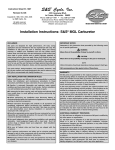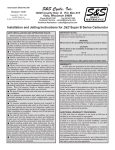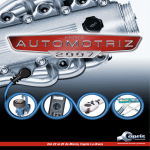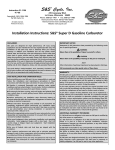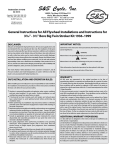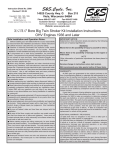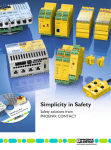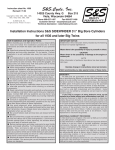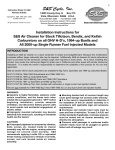Download 51-1010 Two-Throat Instr.
Transcript
S&S Cycle, Inc. ® Instruction Sheet 51-1010 Revised 4-4-06 235 Causeway Blvd. La Crosse, Wisconsin 54603 Copyright®, 2002, 2006 Phone: 608-627-1497 • Fax: 608-627-1488 by S&S Cycle, Inc. All rights reserved. Printed in the U.S.A. Technical Service Phone: 608-627-TECH (8324) Technical Service Email: [email protected] Website: www.sscycle.com Because every industry has a leader Installation Instructions for S&S® TWO THROAT Carburetor (Serial #E1190 & Higher) DISCLAIMER: IMPORTANT NOTICE: S&S parts are designed for high performance, off road, racing applications and are intended for the very experienced rider only. The installation of S&S parts may void or adversely effect your factory warranty. In addition such installation and use may violate certain federal, state, and local laws, rules and ordinances as well as other laws when used on motor vehicles used on public highways, especially in states where pollution laws may apply. Always check federal, state, and local laws before modifying your motorcycle. It is the sole and exclusive responsibility of the user to determine the suitability of the product for his or her use, and the user shall assume all legal, personal injury risk and liability and all other obligations, duties, and risks associated therewith. Statements in this instruction sheet preceded by the following words are of special significance. The words Harley®, Harley-Davidson®, H-D®, Sportster®, Evolution®, and all H-D part numbers and model designations are used in reference only. S&S Cycle is not associated with Harley-Davidson, Inc. SAFE INSTALLATION AND OPERATION RULES: Before installing your new S&S part it is your responsibility to read and follow the installation and maintenance procedures in these instructions and follow the basic rules below for your personal safety. ● Gasoline is extremely flammable and explosive under certain conditions and toxic when inhaled. Do not smoke. Perform installation in a well ventilated area away from open flames or sparks. ● If motorcycle has been running, wait until engine and exhaust pipes have cooled down to avoid getting burned before performing any installation steps. ● Before performing any installation steps disconnect battery to eliminate potential sparks and inadvertent engagement of starter while working on electrical components. ● Read instructions thoroughly and carefully so all procedures are completely understood before performing any installation steps. Contact S&S with any questions you may have if any steps are unclear or any abnormalities occur during installation or operation of motorcycle with a S&S part on it. WARNING Means there is the possibility of injury to yourself or others. CAUTION Means there is the possibility of damage to the part or motorcycle. NOTE Other information of particular importance has been placed in italic type. S&S recommends you take special notice of these items. WARRANTY: All S&S parts are guaranteed to the original purchaser to be free of manufacturing defects in materials and workmanship for a period of twelve (12) months from the date of purchase. Merchandise that fails to conform to these conditions will be repaired or replaced at S&S’s option if the parts are returned to us by the purchaser within the 12 month warranty period or within 10 days thereafter. In the event warranty service is required, the original purchaser must call or write S&S immediately with the problem. Some problems can be rectified by a telephone call and need no further course of action. A part that is suspect of being defective must not be replaced by a Dealer without prior authorization from S&S. If it is deemed necessary for S&S to make an evaluation to determine whether the part was defective, a return authorization number must be obtained from S&S. The parts must be packaged properly so as to not cause further damage and be returned prepaid to S&S with a copy of the original invoice of purchase and a detailed letter outlining the nature of the problem, how the part was used and the circumstances at the time of failure. If after an evaluation has been made by S&S and the part was found to be defective, repair, replacement or refund will be granted. ADDITIONAL WARRANTY PROVISIONS: ● Consult an appropriate service manual for your motorcycle for correct disassembly and reassembly procedures for any parts that need to be removed to facilitate installation. (1) S&S shall have no obligation in the event an S&S part is modified by any other person or organization. ● Use good judgement when performing installation and operating motorcycle. Good judgement begins with a clear head. Don't let alcohol, drugs or fatigue impair your judgement. Start installation when you are fresh. (2) S&S shall have no obligation if an S&S part becomes defective in whole or in part as a result of improper installation, improper maintenance, improper use, abnormal operation, or any other misuse or mistreatment of the S&S part. ● Be sure all federal, state and local laws are obeyed with the installation. ● For optimum performance and safety and to minimize potential damage to carb or other components, use all mounting hardware that is provided and follow all installation instructions. (3) S&S shall not be liable for any consequential or incidental damages resulting from the failure of an S&S part, the breach of any warranties, the failure to deliver, delay in delivery, delivery in non-conforming condition, or for any other breach of contract or duty between S&S and a customer. ● Motorcycle exhaust fumes are toxic and poisonous and must not be inhaled. Run motorcycle in a well ventilated area where fumes can dissipate. (4) S&S parts are designed exclusively for use in Harley-Davidson® and other American v-twin motorcycles. S&S shall have no warranty or liability obligation if an S&S part is used in any other application. The S&S® Two-Throat series carburetor has been designed for all size displacement Harley-Davidson® Sportster® models and big twin engines. The carburetor is of the fixed main jet type with fixed intermediate jets, fixed intermediate air bleeds and an adjustable idle mixture screw. The carburetor has two individual 15/8" throats, each of which supplies a cylinder through a special manifold with separate induction tracts. The carburetor utilizes an accelerator pump to improve throttling response and a conventional choke to aid in cold weather starting. Shovelhead Installation Sportster® Model Installation The S&S Two-Throat series carburetor kit contains the A. Sportster® and Big Twin Installation following items: One carburetor. One air cleaner with mounting bracket. One intake manifold, insulator block, gaskets & bolts. One fuel line and two clamps. Two extra sets main jets. Two extra sets intermediate air bleeds. One extra sets intermediate jets. One bowl overflow hose. 1. The old carburetor and manifold must be removed and the manifold supplied with the kit installed. If the carburetor is to be used on a knucklehead or panhead, a bracket is furnished that bolts to the center crankcase stud and the bottom front manifold bolt. When this bracket is used, the bottom front manifold bolt supplied is 1/8" longer and must be used in the bottom front hole only. For installation on Sportster® models, a bracket is furnished that bolts to the front intake cam stud and the air cleaner back plate. On shovelheads, a bracket that bolts to the front cylinder rocker box cover and the back plate is used. After the manifold is installed, temporarily bolt the carburetor in place. 2. A two cable "pull-pull" type throttle handle assembly should be used with the Two-Throat carburetor. This S&S carburetor is fitted with an accelerator pump, and because of the additional mechanical pump linkage, the throttle arm assembly has provisions for the two cable system to insure a positive on-off throttle movement. 2 WARNING We do not recommend the use of this carburetor with the single cable throttle assembly. In the interest of operator safety, we strongly urge installation of a twocable throttle. The 1981 and later Harley-Davidson® throttle handle assembly can be adapted for use, or if one chooses, S&S® Cycle, Inc. can provide or reasonably price a high quality two cable assembly with extra long 48" cables. (Complete S&S two-cable throttle assembly is Part #11-0279). a. The stock throttle on 1981 and later models can be adapted by soldering the last 11/2 of inner cable before cutting the ball or barrel fitting off the end. The soldering is done to prevent the strands from separating. Once this operation is done, remove the carburetor and feed the cables through the appropriate bosses on the carburetor. The cable with the larger diameter outer housing is used to close the throttle and should be positioned in the bracketed housing, Part #11-2239, which is attached to the bowl. When rotating the throttle handle counterclockwise, looking at the end of the handlebar, the throttle will open if the cables are correctly routed. A little freeplay should be left in both cables when tightening the throttle arm cable clamp set screws. Any excessive play can be adjusted out at the throttle grip cable adjusters before engine startup. b. If the S&S two cable throttle handle assembly is used, the procedure for installation is much the same except the outer cables are 48" long and are both of the same diameter. This means you may have to shorten the outer cables if they are too long for your particular installation Determine the best routing for the outer cables then clip the ends at the carburetor once you have determined the correct length. If you shorten the outer cables, you must also shorten the inner cables, but be sure to determine the proper length and resolder the last 1-11/2" of inner cable before cutting. This will insure the cable strands do not separate. Apply a light coat of lubrication to the inner cables and complete the installation. NOTE - After all cable adjustments are made, work the throttle several times while turning the handlebars to extreme right and left before engine startup to be sure the throttle is snapping off and closing shut all the way. If the throttle fails to snap shut or close all the way, determine the cause and correct before engine startup. NOTE - A thin coating of light grease should be applied to the throttle arm cam, Part #11-2248, where it contacts the transfer arm, Part #11-2277, to insure minimized friction and smooth throttle operation. This grease is necessary only for the Iast two weeks or so of operation until a smooth wear pattern is established. Do not lubricate the pump pushrod, Part #11-2267 3. After installing the throttle assembly, bolt the carburetor in place using the allen head bolts provided. NOTE - For installation on big twins, the stock wire fuel line bracket should be used to position the fuel line between the cylinders. 4. The fuel line supplied should be used in place of the stock line. For Sportster® models, the line is bent sharply to the rear of the bike over the carburetor and then around to the inlet fitting on the bowl. Secure the line on both ends with the clamps. The fuel line on big twins can normally be routed between the cylinders. Check or leaks before starting the engine. WARNING Some bikes are equipped with exhaust systems that curve around the gear cover directly under the carburetor. The fuel line must not touch the pipe or be placed in a position where it is exposed to extreme heat. NOTE - We strongly suggest that an in-line fuel filter be used and spliced into the fuel line to keep foreign material out of this carburetor. With the small metering holes used in the intermediate system and the accelerator pump nozzles, it is wise to insure against contamination to provide trouble free operation. 5. The Two-Throat carburetor features a bowl overflow system. In the event the rider forgets to shut off the fuel petcock and the needle and seat assembly sticks, the excess fuel will flow out through the overflow hose rather than fill the cylinders with fuel. For Sportster® model installations, the hose should be routed between the front cylinder pushrod covers and down between the crankcase and generator. For big twin installations, the hose should be routed between the rear cylinder pushrod covers and down between the crankcase and transmission. 3 WARNING Remember, however, the bowl overflow system is a safety aid only, and does not mean you do not have to turn off the fuel petcock. Always turn off the fuel petcock when the engine is not running. 6. With the fuel line in place, the air cleaner backplate and mounting bracket can be installed. NOTE - Before installing the air cleaner backplate, Part #17-0280, be sure any flash is removed from the formed holes, especially the bowl vent hole which is positioned between the air horns just below the middle top mounting screw hole, and the small drain hole positioned near the middle bottom of the backplate. The bowl vent hole matches up with a hole in the carburetor body. If this hole is blocked or restricted, the carburetor will not run properly. a. The Sportster® model bracket bolts to the front intake cam cage stud and to the front die-cast hole in the air cleaner backplate. The shovelhead bracket bolts to the hole in the front rocker box cover just to the rear of the front intake pushrod and the die cast hole in the backplate which is positioned closer to the front airhorn. b. Before final tightening of the manifold clamps and mounting bracket, visually check the motorcycle from the front to insure the carburetor is horizontal when the bike is held upright. c. Immerse the foam portion of the air cleaner element in a light weight engine oil and squeeze out. Before final assembly of the air cleaner, check the needle and seat for possible leakage. Hold the motorcycle level and turn the fuel petcock on. If gas does not leak out of the end of the carburetor bowl overflow hose after 10 seconds, the element and air cleaner cover can be installed. The chrome wire mesh screen must be bent to a smooth curve and inserted in the front of the air cleaner cover. If the needle and seat do not hold, the bowl should be removed and checked. See the "General Information" section of these instructions for details. 7. Special instructions for engines equipped with breather vent line to the air cleaner. a. S&S® air cleaners have a special boss cast into the air cleaner backplate designed especially for this vent. The backplate should be drilled and tapped for a 1/8" pipe nipple. This can be procured at most any hardware store. After the air cleaner backplate modification is done, the vent line should be secured with a clamp. B. Starting Procedure This carburetor has a conventional choke type starting mechanism. It has a tension spring, Part #11-2144, that constantly applies pressure against the choke lever, Part #11-2246, so that it will remain in position once set. The choke plates, Part #11-2273, are fully closed when the lever is pulled up to the stop. The S&S TwoThroat carburetor also has an accelerator pump which will squirt a stream of fuel directly into each manifold opening when the throttle is opened quickly. 1. Cold Starts a. One may use the accelerator pump to prime a cold engine rather than the full choke method. Wait for 10 seconds after turning on the fuel petcock and then prime the engine by giving two quick wide open throttle movements. Then kick with the choke in the 2/3 closed position and the throttle slightly opened. But be careful as it is easy to flood the engine with the accelerator pump. If you think the engine is flooded, open the throttle slowly to the wide open position. By opening the throttle slowly the pump is not actuated. Also open the choke and then kick through until the engine starts or the flooded condition is cleaned out. b. During our extensive testing with this carburetor, we eventually got to the point where we rarely used the choke, normally accomplishing most cold starts by priming with the pump only. c. 4 Motors will react differently due to the type of cams or pipes, etc. and you will have to experiment with your particular bike until you find the best starting procedure for your own set of circumstances. 2. Hot Starts 1. Hot starting does not normally require the use of the choke or pump priming. Starting is usually accomplished by turning on the ignition and kicking with the throttle closed. 3. Electric Start Model CAUTION Never close the idle mixture screw tightly as damage to the needle and seating area in the carburetor body may result. The throttle stop engine RPM adjustment screw located on the throttle arm, Part #11-2248, is initially set by holding the throttle closed and turning the screw until it contacts the throttle arm stop boss. At this point it is turned an additional 1/2 turn clockwise. b. Start the engine and warm it up to operating temperature. Adjust the engine RPM to a slow idle, approximately 800 RPM. Then turn the idle mixture screw in, leaning it, until the engine starts to die. Next, turn the screw back out, richening it, until it starts to die. A position about halfway between these points, or a setting of about 1/2 a turn out from the lean side of the range is the correct setting. From the fully closed position this would be approximately 2 to 3 turns. Then reset the throttle stop screw to give final desired RPM idle speed. Idle speeds will vary according to the individual and the use to which the machine is put. a. Close the choke halfway, turn on the ignition, and with the throttle slightly cracked engage the starter. After the engine starts, open the choke and work the throttle slightly until the engine will idle. Trouble Shooting Tips Engine will not start: ● ● Fuel supply empty or restricted. Weak or no spark - discharged battery or faulty magneto. NOTE - We do not recommend tho use of magnetos. ● ● ● ● ● ● Plug gap too wide - we use .020 to .022 plug gap on our point type ignition engines. Improper ignition timing. Tight tappet adjustment. Improper idle mixture and/or engine RPM setting. Intermediate jets or air bleeds loose. Improper diagnosis of a rich or lean mixture condition. If the engine fires in the carb, it is too lean and must be re-primed. Do not continue to kick the engine over with the switch on until it is reprimed. If there is no response after three kicks or if it pops in the exhaust pipes, it is too rich. Leave the switch on and open the throttle wide open and kick until it fires. C. Adjusting the Carburetor 1. Idle Circuit a. The idle mixture screw, Part #11-2354, is initially set during assembly to 21/2 turns out from the fully closed position. Check this and reset the screw to 21/2 turns before attempting to start the engine. NOTE: Whenever an intermediate system jetting change is made, the idle mixture screw should be readjusted with the engine hot. Trouble Shooting Tips Engine will not idle. ● ● ● Improper idle mixture and/or engine RPM setting. Intake manifold air leak. Sticky timing automatic advance mechanism. NOTE - On those engines with spring loaded mechanical advance ignition systems, we perform as standard procedure to each of our motors, the following modification: Remove and clean the timing advance mechanism. Rebend the small springs which retard the timing by shortening each spring 1/16" on both ends to increase spring tension. This will insure the engine retards properly and returns to a smooth, low idle. We have found that this normally cures those conditions where the motor will not always return to a low idle and instead sometimes idles at a higher speed, up to 1400-1600 RPM . ● ● Foreign material obstructing gas flow to idle circuit. Incorrect intermediate jetting. 5 2. Intermediate System Up to 3000 RPM or 55-60 MPH a. For normal riding conditions, the intermediate range is used the most. Therefore, close attention must be paid to jetting the mid-range to achieve optimum performance and gas mileage. Once the engine is warmed up and the idle mixture and engine RPM screws set, the bike must be road tested. The intermediate range is used from right off idle up to approximately 3000-3500 RPM or 50 to 60 MPH depending on gearing. Throttling characteristics can be checked by slowly opening the throttle (so as to not energize the accelerator pump) after maintaining a steady speed. This can be done at several RPM levels or speeds of 30, 40, and 50 MPH. If popping or spitting occurs in the air cleaner, this is a lean condition and should be corrected. Another indication of a lean intermediate system can be noticed by feeling a "flat" or "laboring" condition while cruising at 55 to 60 MPH, right at the top of the intermediate range. NOTE - As mentioned earlier, it is extremely critical that the idle mixture screw and throttle stop screw be adjusted with a hot motor. The idle will effect the intermediate system and if it is not adjusted properly, one will not get a true reading as to the performance of the intermediate. b. If the intermediate system is too rich, it may show up by popping in the pipes, a "lope" or miss at lower RPMs, or a miss or stutter at transition, about 3000 to 3500 RPMs, especially in low gear under reduced load conditions. c. To lean the intermediate, install a smaller set of intermediate jets, Part #11-7300. One may also make subtle changes by bleeding in more air by installing larger air bleeds, Part #11-7320. d. To richen the intermediate system, install a larger pair of intermediate jets and/or smaller air bleeds NOTE - A properly jetted intermediate system will act lean (cough or spit) when the engine is cold and will require riding a few miles to warm the engine to operating temperature. 6 e. Higher altitude or hot, dry weather may require a leaner mixture (smaller intermediate jets and/or bigger air bleeds) while lower altitude, cold weather, or a warm and humid climate may require a richer mixture (larger intermediate jets and/or smaller air bleeds) to dial the system in properly. f. We have run a: 1. 900cc Harley-Davidson® Sportster® model with the .029-.046 intermediate combination. 2. 1000cc Sportster® model with .030-.046. 3. Stock 74" panhead with .029-.046. 4. 80" shovelhead with .030-.046. 5. 98" shovelhead with the .033-.046 combination. 3. Main Jet From 3000 RPM or 55-60 MPH and up: a. Main jetting is best determined by testing at the drag strip. Jetting should always be done at operating temperature. After a run is made, the engine RPM and final speed should be noted. A second run should be made with a .004 larger, richer, jet installed. Again, RPM and final speed is noted. This procedure should be continued until the miles per hour falls off. The main jet should then be made smaller (leaner) to gain the best maximum RPM and MPH. When making these runs, do not strive for ETs, but for consistent miles per hour. We have found that maximum miles per hour and RPM have been the best indicators of proper jetting. b. If the engine is buttoned off after each run, the spark plugs may be inspected for richness or leanness. Plug color though is not always a good indication of carb jetting on quarter mile tests. We have found that different brands of gasoline, gasoline additives, engine heat (due to ignition timing), and type of plugs and heat range used alter readings drastically. New plugs usually require the time involved in a road test to properly develop the plug color. It is best to use a proven combination and to consult the spark plug manufacturer for more specific information if one desires to become proficient at plug reading. Champion Racing Division has a very informative booklet. For details, write: Champion Spark Plug Company P.O. Box 910 Toledo, Ohio 43601 c. If main jetting tests cannot be conducted at the drag strip, the "RPMing" method can be used. This procedure would be to run the bike through the gears noting how quickly and smoothly the engine reaches the RPM level where gears are shifted. Under racing conditions this level is where horsepower peaks and begins to taper off. The main jet that makes the engine pull the strongest or RPM through the gears best is the correct one. Our experience is that a jet about .006 smaller (leaner) in size will make the engine pop and sputter or "break up" in the carburetor and die. A jet about .006 larger (richer) will make the engine run flat and sluggish or "blubber". d. On certain engines, particularly Sportster® models, an indication of a rich main jet condition will sometimes appear as a slight miss at transition from the intermediate system to the main jets. e. If this occurs while running hard through the gears at 3000-4000 RPM, try smaller main jets. f. We 1. 2. 3. 4. 5. have run: 900cc Sportster® models with .050 main jets. 1000cc Sportster® models with .052's. Stock 74" panhead with .050's. 80" shovelhead with .052's. 98" shovelhead with .056's. Trouble Shooting Tips Engine will not run at steady speed: ● ● ● ● ● ● Restriction in fuel supply system - gas tank vent plugged, gas petcock too small (stock HarleyDavidson® petcock is adequate, but might require running on reserve to provide adequate supply for big inch engines), needle and seat assembly not working properly. Faulty ignition system - fouled plugs, worn points, defective coil. Incorrect intermediate and/or high speed jetting. Foreign material in air and/or gas passageway in carb causing flow restriction. Remove and clean intermediate jets and bleeds. Valve train defect - bad valves, sticky valves, bad or broken springs, improper clearances for high lift cams. Bowl vent obstructed. Engine ● ● ● ● will not RPM: Restriction in fuel system. Faulty ignition system. Incorrect high speed jetting. Foreign material in air and/or gas passageways in carb causing flow restriction. ● Too much gear. (Not enough horsepower to pull the gearing.) ● Valve train defect. ● Bowl vent obstructed. g. The above was warm weather jetting at 600 to 1000 feet above sea level elevation. h. Obviously, like the intermediate jetting, the main jet requirements will vary somewhat with conditions. 7 D. General Information 1. Do not chrome the carburetor as extensive damage will result. Top Bevels must be at angles shown when installing throttle plate. 2. The carburetor has several drilled passages that are permanently sealed with plugs. Do not attempt to remove these plugs. 3. Do not over-tighten the idle mixture screw, intermediate jets, or intermediate air bleeds. Side View 4. The throttle plates. Part #11-2255, and throttle shaft, Part #11-2254, should be checked annually for signs of wear. Replace, if necessary. If they are removed, be sure that the throttle plates are reinstalled correctly. See Figure A. 5. If the throttle arm, Part #11-2248, is removed from the throttle shaft, it must be reinstalled in the wide open position with the butterfly at 90° to the fully closed position. See Figure B. 6. The correct float level adjustment is shown below in Figure C. When the motorcycle is not running, the fuel shutoff valve should always be turned of. In the event fuel runs out of the bowl overflow hose, remove the bowl assembly and inspect the float and needle and seat assembly to be sure it doesn’t bind and the float level is properly set. See Figure C. 7. If an air cleaner other than ours must be used, make sure the bowl vent hole in the inlet end of the carburetor is not covered and sealed off. Figure A 8. Cams and exhaust systems make some engines difficult to carburate. A combination of cam overlap and back pressure, or lack of back pressure will cause mixture dilution at certain engine RPMs. This dilution will cause engine roughness or misfiring when the engine is held in this range. To attempt to carburate for this condition usually destroys the carburetion over the rest of the range. It is best under these conditions to change the cam and/or the exhaust system. 9. S&S® has found that stock head pipes equipped with a good quality slip-on muffler will provide a nice amount of horsepower and torque. 10. Use a fuel filter to keep dirt out of this carburetor. With the small metering holes used in the intermediate system and the accelerator pump nozzles, it is wise to insure against contamination to provide trouble free operation. Throttle plate horizontal Throttle arm against stop Throttle arm set screw Side View Figure B 8 Bowl is shown upside down. Side View Figure C 11. For those involved in an "all-out" drag racing effort using very large displacement engines, you may consider: a. Raising the float level 1/8", b. To improve air-flow, removing the choke assembly and plugging the choke shaft holes in the carb body as well as running without the air cleaner element. You may also elect to run the 1" spacer block, Part#16-0295, and do some porting work to the induction tract to further improve air flow. 12. In closing, remember that this carburetor has large venturi compared to the stock unit. This means that at low RPMs, velocity through the carburetor is very low and it is more difficult to energize the main jet, particularly on stock displacement big twin or Harley-Davidson® Sportster® models. Because of the design and with the addition of an accelerator pump. one can generally "whack" the throttle on at lower RPMs and still pick up the main jet. With our stock l000cc Sportster, we were able to "whack it on" at 1200 RPM in low, 1600 RPM in second, 2000 RPM in third and 2500 RPM in high. Below those RPMs, we either down-shifted or slowly rolled the throttle on until RPMs were up sufficiently to pick up the main jet. After getting your particular engine jetted properly, you will have to experiment with the throttling characteristics as this will vary with different motor configurations. E. Jetting Tips 3. The idle mixture screw, Part #11-2354, is located on the top of the carburetor. Turning the screw clockwise (in), will lean the mixture. A counterclockwise motion (out), will richen the mixture. 4. The intermediate jets, Part #11-7300, are available in sizes from .028 to .034 in graduations of .001 with .034 being the richest. Normally, .029 to .033 sizes are used. 5. The intermediate air bleeds, Part #11-7320, are made in sizes .028, .032, .036, .040, .043, .046, .052, .055, .059, and .063, with .063 being the leanest. Normally bleeds in the middle of the scale will be used. 6. The main jets, Part #11-7200, are made in increments of .002 and range in size from .040 to .060, with .060 being the richest. They can be changed after removing the bottom bowl plugs. 7. When changing any jets, be sure to change in pairs, as each throat or "barrel" has its own set of jets. 8. Upon warming the engine to normal operating temperature after making any jetting changes to the intermediate system always readjust the idle mixture screw. Below is a chart with some basic guidelines to follow while jetting your Two-Throat carburetor. 1. Use a fuel filter to insure foreign material does not enter this carburetor. Mild Strokers Large Engines 61"-74" 80"-84" 86" & up ® Sportster models 55"-61" Up to 74" 75" & up Idle Mixture Screw 2-3 turns 2-3 turns 2-3 turns Intermediate Jet .029-.030 .030-.031 .032-.033 Intermediate Bleed .040-.052 .040-.052 .040-.052 Main Jet .046-.054 .048-.056 .052-.060 Big Twin 2. The Two-Throat has an adjustable idle mixture screw, fixed intermediate jets, fixed intermediate air bleeds and fixed main jets. Stock CID 9 Two-Throat Carburetor Replacement Parts 1. Choke/throttle plate screw 6-32 x 1/4" . . . . . . . . . . . . . . . . . . . . . . .11-0055 2. Idle mixture screw spring . . .11-2052 3. Idle mixture screw . . . . . . . . .11-2354 4. Seat . . . . . . . . . . . . . . . . . . .11-2065 5. Main jet - See "Jetting Chart". 6. Air cleaner cover screw (10 Pack) . . . . . . . . . . . . . . . . .50-0094 7. Throttle return spring . . . . . .11-2082 8. Back plate-bowl screw with lockwasher 10-24 x 5/8" (10 Pack) . . . . . . .50-0062 43. Choke plate . . . . . . . . . . . . . .11-2273 44. Diaphragm spring . . . . . . . . .11-2275 26. Intermediate jet - See "Jetting Chart". 45. Pump lever . . . . . . . . . . . . . .11-2276 27. Throttle shaft . . . . . . . . . . . . .11-2254 46. Transfer arm . . . . . . . . . . . . .11-2277 28. Throttle plate . . . . . . . . . . . . .11-2255 47. Air cleaner cover . . . . . . . . .17-0278 29. Gasket - manifold . . . . . . . . .16-0256 48. Air cleaner element . . . . . . .17-0279 30. Cover - pump cap . . . . . . . . .11-2257 49. Back plate . . . . . . . . . . . . . . .17-0280 31. "Y" manifold All Harley-Davidson® Sportster® models . . . . . . . . . . . . . . . .16-4300 Shovels 1979 & earlier . . . .16-4316 50. Diaphragm . . . . . . . . . . . . . .11-2282 32. Manifold screw - 20 x 13/8" Shovel, Sportster® models or Pan (10 Pack) . . . . . . . . . . . . . . . . .50-0153 51. Pump cap . . . . . . . . . . . . . . . . . .N/A 52. Lever screw . . . . . . . . . . . . .11-2285 53. O-ring (10 Pack) . . . . . . . . . . .50-8096 54. Bowl . . . . . . . . . . . . . . . . . . . . . . .N/A 55. Gasket, bowl . . . . . . . . . . . . .11-2289 56. Air cleaner screen . . . . . . . .17-0290 10. Needle . . . . . . . . . . . . . . . . .11-2095 33. Manifold screw - 1/4 - 20 x 2" For use with spacer block. . . . . .N/A 11. Support bracket bolt . . . . . . . . . .N/A 34. Ovorflow hose . . . . . . . . . . . .19-0262 12. Support bracket locknut . . . . . . .N/A 58. Air cleaner support bracket Shovelhead . . . . . . . . . . . . . . . . .17-0292 13. Choke arm screw . . . . . . . . .11-2143 35. Manifold screw - 1/4 -20 x 11/2" Bottom front only for panheads . .N/A 14. Choke spring . . . . . . . . . . . . .11-2144 36. Panhead manifold 15. Choke washer 37. Bellows seal . . . . . . . . . . . . .11-2266 16. Intermediate air bleed See "Jetting Chart". 39. Float screw 10-32 x 1/4" . . . . .50-0036 17. Float . . . . . . . . . . . . . . . . . . . . . . .N/A 40. Float pin . . . . . . . . . . . . . . . .11-2269 18. Cable housing bracket . . . . .11-2339 41. Actuator pin . . . . . . . . . . . . . .11-2271 19. Choke shaft . . . . . . . . . . . . . .11-2246 42. Ball check 9. Bottom plug . . . . . . . . . . . . .11-2090 20. Body . . . . . . . . . . . . . . . . . . .11-2247 21. Throttle arm assembly . . . . .11-2248 22. Screw with lock washer 6-32 x 5/16 . . . . . . . . . . . . . . . . . . .N/A 23. Main discharge tube . . . . . . .11-2250 10 24. Transfer arm screw . . . . . . . .11-2251 25. Gasket - pump cap cover . . .11-2252 38. Pushrod - pump . . . . . . . . . .11-2267 (10 Pack) . . . . . . . .50-8125 57. Insulator block . . . . . . . . . . .16-0291 59. Air cleaner support bracket Sportster® models . . . . . . . .17-0293 60. Pump cap screw lockwasher 8-32 x 7/16" . . . . . . . . . . . . . . . . . . . . . . . . . . . . . .N/A 61. 1" Spacer block (optional) . .16-0295 62. Air cleaner support bracket - panhead . . . . . . . . . . . . . . . . . . . . . . .16-0296 32 33 61 31 29 7 13 1 26 27 14 2 16 57 29 32 3 15 36 19 35 1 49 28 62 48 20 23 8 43 56 21 55 5 17 42 44 40 11 39 53 54 58 6 59 50 24 53 10 12 41 46 8 34 34 9 18 37 38 51 45 60 25 30 22 4 11 Because every industry has a leader












